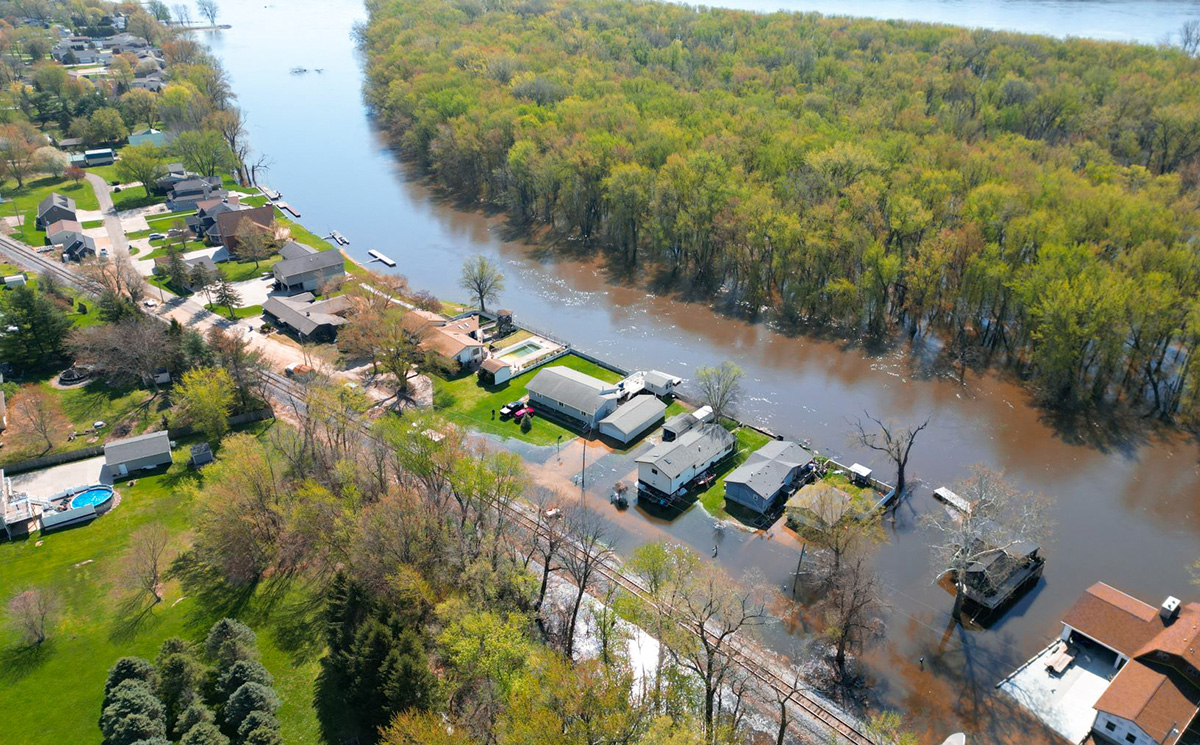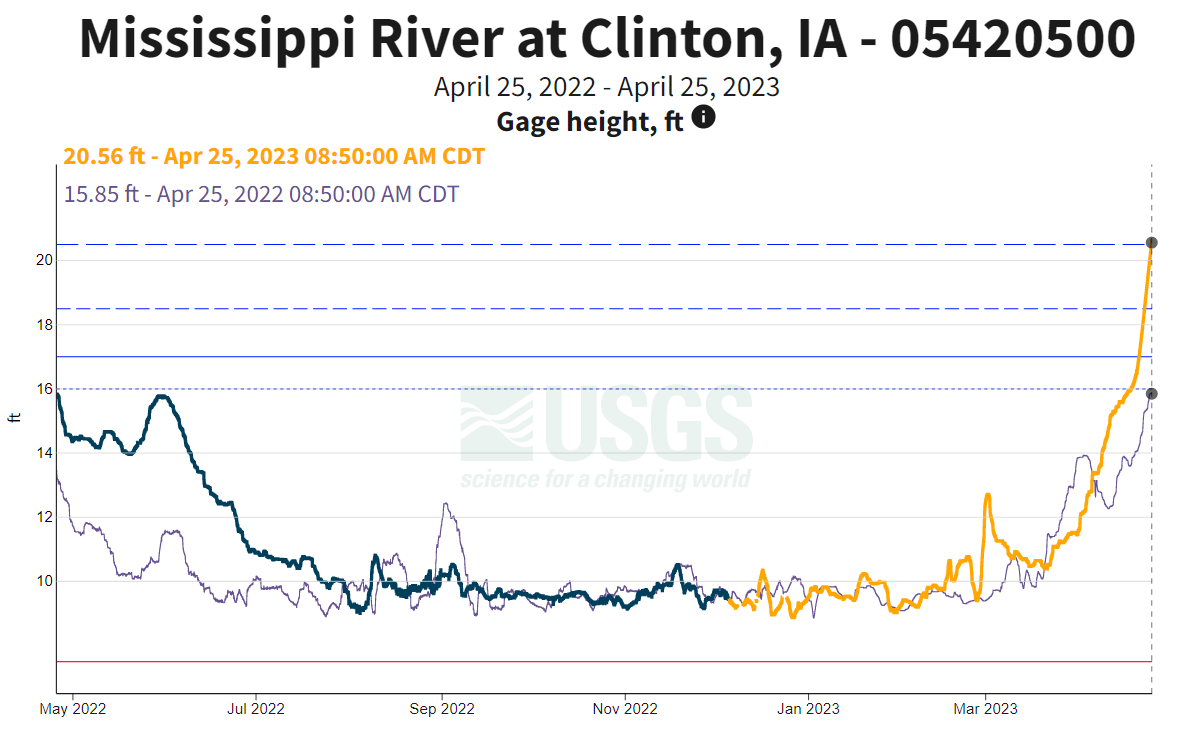
Flooded Mississippi River (Photo: City of Camanche)
River woes continue on the Mississippi
April 26, 2023
This past autumn it was diminished water levels that hit barge transportation along the Mississippi River and other waterways. A scarcity of precipitation was impacting water depths along navigable waterways, affecting the transport of soybeans, fertilizer and more.
But substantial snow melt and recent rains in the upper Midwest have now prompted a significant jump in water levels, presenting challenges for barge transportation particularly along the Upper Mississippi River.
“This spring has served as a reminder how the pendulum can dramatically swing regarding navigation on the inland waterway system,” says Mike Steenhoek, executive director of the Soy Transportation Coalition (STC), an organization comprised of 13 state soybean boards, including the Iowa Soybean Association (ISA), the American Soybean Association and the United Soybean Board. Steenhoek closely monitors challenges and opportunities to improve the efficiency of transportation for soy shippers and customers.
Steenhoek says significant snowfall and rain over the past number of weeks has resulted in a sizable increase in water levels.
“In many of the northern areas of the Midwest, temperatures have remained cold, which results in the ground behaving more like a tabletop vs. a sponge when the snow melts or rainfall occurs,” he says. “Water is therefore expedited to streams and rivers.:
ISA Director Dave Walton, who farms near Wilton and not far from the Mississippi River, says the body of water is closed to navigation until water levels recede.
“The irony of the river situation is that not long ago, barges couldn’t move up and down the river because there wasn’t enough water,” he says. “Now we’re talking about too much water. Both have impacts on river commerce.”
Walton has come to expect an impact given his proximity to the river. The seventh-generation farmer is just 15 miles from the Mississippi River. The river is his farm’s link to global customers. Most of his grain is exported via the Mississippi River through New Orleans and on to other end users.
Many Mississippi River locks between St. Paul, Minnesota, and Quincy, Illinois, have closed due to the high-water conditions. Some will remain closed until the first and second week of May, according to Steenhoek.
Closures of these locks, he says, “will obviously impede the delivery of any remaining soybeans or grain for the export market, but lock closures during this time of the year will particularly impact northbound fertilizer shipments.”
The U.S. Department of Agriculture estimates that 2.4 million tons of fertilizer have been delivered during the first three months of this year. That is down 16% from the same period last year and 5% below the five-year average.
By the numbers
Mississippi River stage at Winona, Minnesota:
- Lowest gage reading in 2022: 5.23 ft. (March 17, 2022)
- Highest gage reading in 2022: 11.52 ft. (May 23, 2022)
- Action stage (the stage at which a rising water level will begin to trigger mitigation measures by the authority in charge): 11 ft.
- Minor flood stage: 13 ft.
- Major flood stage: 18 ft.
- Current stage: 18.7 ft (April 25, 2023)

Mississippi River stage at Clinton, Iowa:
- Lowest gage reading in 2022: 8.86 ft. (Jan. 2, 2022)
- Highest gage reading in 2022: 15.85 ft. (April 25, 2022)
- Action stage (the stage at which a rising water level will begin to trigger mitigation measures by the authority in charge): 16 ft.
- Minor flood stage: 17 ft.
- Major flood stage: 18.5 ft.
- Minimum operating limit: 7.5 ft.
- Current stage: 20.56 ft. (April 25, 2023)
Mississippi River stage at St. Louis, Missouri:
- Lowest gage reading in 2022: -3.53 ft. (Dec. 25, 2022)
- Highest gage reading in 2022: 29.61 ft. (May 7, 2022)
- Action stage (the stage at which a rising water level will begin to trigger mitigation measures by the authority in charge): 28 ft.
- Minor flood stage: 35 ft.
- Major flood stage: 40 ft.
- Minimum operating limit: -4.97 ft.
- Current stage: 16.11 ft. (April 25, 2023)
Mississippi River stage at Memphis, Tennessee:
- Lowest gage reading in 2022: -10.79 ft. (Oct. 22, 2022)
- Highest gage reading in 2022: 30.71 ft. (March 9, 2022)
- Action stage (the stage at which a rising water level will begin to trigger mitigation measures by the authority in charge): 28 ft.
- Minor flood stage: 34 ft.
- Major flood stage: 46 ft.
- Minimum operating limit: -12 ft.
- Current stage: 10.56 ft. (April 25, 2023)
Steenhoek says the snow and rain in the upper Midwest will more dramatically impact water levels at these locations compared to those locations further south at which point the Mississippi River is wider and the geographic area is more distributed.
Walton, meanwhile, says he’s going over every nut and bolt on his equipment before the expected start of soybean planting in his fields yet this week. Cooler temperatures - not river levels - have held Walton back from planting.
“It’s been more cold than wet,” he says. “I probably could have started planting a few weeks ago, but it wasn’t worth the risk to me.”
Bethany Baratta contributed to this report.
Back